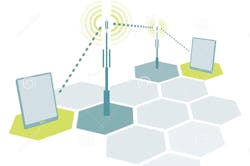Leverage RF Power Meters For EM Compatibility Testing
This file type includes high resolution graphics and schematics when applicable.
As the complexity of modern telecommunications equipment increases, related standards and methods of testing them do as well. Recent changes to electromagnetic-interference (EMI) and electromagnetic-compatibility (EMC) testing standards have added an impulse RF spike of either 5 or 100 kHz. This impulse is used to emulate the effects of a high-powered base-station communications amplifier or a ground-based-radar antenna burst. In order to improve repeatability, increase dynamic range, and more accurately measure pulse power, an engineer may consider using a peak power sensor in place of a traditional diode detector. Bob Muro of Boonton, a Wireless Telecom Group company, provides insight into this topic in the four-page whitepaper, “Using RF Power Meters for EMC Testing.”
As an electrical science, EMC studies the susceptibility of electronic devices to compromised operation in response to EMI signals. A device is considered to have achieved EMC when its design addresses both the emission and susceptibility aspects of its operation. Immunity testing is critical for a variety of electrical systems that could be negatively impacted by significant radiation, such as the CANBUS system for intercommunication of vehicular subsystems. In an EMI/EMC test, a radiative source generates an RF impulse and the victim device is subjected to the radiation while operating. This testing is often done in an anechoic test chamber to avoid misreading the measurements caused by reflections.
The single-step closed-loop method or two-step substitution method are commonly used for such testing. The closed-loop method has the detector and device-under-test (DUT) in the same test chamber. The substitution method uses the detector as a calibration of the radiative source prior to testing the DUT. For both methods, a peak power sensor that can correctly calculate the power values of a signal (when it is either pulsed or under modulation) would provide a more dynamic and accurate measurement of power levels. This improvement over a diode detector could give engineers a better understanding of a device’s EMC while showing whether it complies with the necessary standards.
Boonton, 25 Eastmans Rd., Parsippany, NJ 07054; (973) 386-9696.
This file type includes high resolution graphics and schematics when applicable.
About the Author
Jean-Jacques DeLisle
Jean-Jacques graduated from the Rochester Institute of Technology, where he completed his Master of Science in Electrical Engineering. In his studies, Jean-Jacques focused on Control Systems Design, Mixed-Signal IC Design, and RF Design. His research focus was in smart-sensor platform design for RF connector applications for the telecommunications industry. During his research, Jean-Jacques developed a passion for the field of RF/microwaves and expanded his knowledge by doing R&D for the telecommunications industry.

